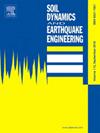天然砂岩和水饱和砂岩在动荷载作用下的渐进破坏力学和断裂机制研究
IF 4.2
2区 工程技术
Q1 ENGINEERING, GEOLOGICAL
引用次数: 0
摘要
为了研究天然砂岩和含水砂岩在循环冲击载荷作用下的力学特征和损伤演化规律,采用分离式霍普金森压杆对砂岩进行了循环冲击试验,分析了砂岩在天然状态和水饱和状态下的损伤演化规律,建立了砂岩损伤模型。结果表明,虽然弹性模量和峰值应力随循环冲击次数的增加而降低,但砂岩在自然状态和水饱和状态下的应变速率都在上升。在相同的冲击速度下,天然含水状态和饱和状态下的峰值应力分别为 25.53 兆帕和 23.63 兆帕、37.25 兆帕和 43.35 兆帕、64.82 兆帕和 54.34 兆帕。这清楚地表明,砂岩在天然含水状态下的峰值应力明显高于饱水状态下的峰值应力,而且随着速度的增加,峰值应力也明显增加。峰值应变下的破坏变量分别为 0.45 和 0.55、0.53 和 0.61、0.62 和 0.69,砂岩在天然状态下的破坏小于饱和状态下的破坏,且冲击速度越大,破坏越大。利用统计损伤理论和回归分析成功建立了砂岩损伤模型,模型的总体拟合效果良好。研究表明,水会降低砂岩的机械强度,但当动荷载增加时,机械强度会提高。在循环冲击条件下,存在临界动荷载情况。较小的动荷载会导致砂岩机械强度先上升后下降,而较高的荷载则会导致砂岩机械强度呈下降趋势。最后,总结了实验研究的结果,并提供了一个预测模型,用于预测砂岩样本在各种含水条件下的动态破坏情况。本文章由计算机程序翻译,如有差异,请以英文原文为准。
Study on progressive damage mechanics and fracture mechanism of natural and water-saturated sandstones under dynamic load
In order to study the mechanical characteristics and damage evolution law of natural and water-bearing sandstone under cyclic impact load, cyclic impact test was carried out on sandstone by separating Hopkinson compression bar, the damage evolution law of sandstone in natural and water-saturated state was analyzed, and sandstone damage model was established. It was shown that while the modulus of elasticity and peak stress decreased with the number of cycle impacts, the strain rate of sandstones in both their natural and water-saturated states rose. The peak stresses in the natural water-bearing state and the saturated state were 25.53 MPa and 23.63 MPa, 37.25 MPa and 43.35 MPa, 64.82 MPa and 54.34 MPa, respectively, under the same impact velocity. This clearly demonstrated that the peak stress of sandstone was significantly higher in the natural water-bearing state than it was in the water-saturated state, and that the peak stress increased significantly with the increase in velocity. The damage variables under the peak strain are 0.45 and 0.55, 0.53 and 0.61, 0.62 and 0.69, and the damage of sandstone in the natural state is less than that in the saturated state, and the greater the impact velocity, the greater the damage. A sandstone damage model utilizing statistical damage theory and regression analysis was successfully established, and the overall fit of the model was good. It was shown that water decreases the mechanical strength of sandstone, but increases it when the dynamic load is increased. Under cyclic impact conditions, there is a critical dynamic load situation. Smaller dynamic loads cause an increase, followed by a drop in sandstone mechanical strength, whereas higher loads cause a decreasing trend in sandstone mechanical strength. Finally, the experimental study's findings are summarized, and a prediction model for forecasting the dynamic damage of sandstone samples in various water bearing conditions is offered.
求助全文
通过发布文献求助,成功后即可免费获取论文全文。
去求助
来源期刊

Soil Dynamics and Earthquake Engineering
工程技术-地球科学综合
CiteScore
7.50
自引率
15.00%
发文量
446
审稿时长
8 months
期刊介绍:
The journal aims to encourage and enhance the role of mechanics and other disciplines as they relate to earthquake engineering by providing opportunities for the publication of the work of applied mathematicians, engineers and other applied scientists involved in solving problems closely related to the field of earthquake engineering and geotechnical earthquake engineering.
Emphasis is placed on new concepts and techniques, but case histories will also be published if they enhance the presentation and understanding of new technical concepts.
 求助内容:
求助内容: 应助结果提醒方式:
应助结果提醒方式:


